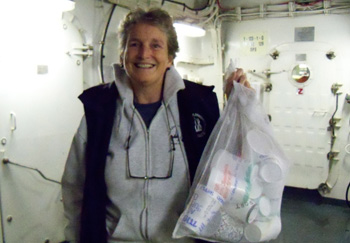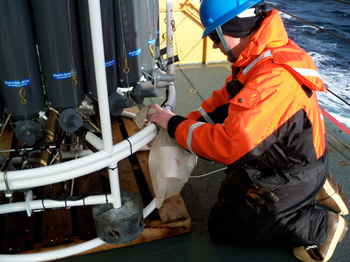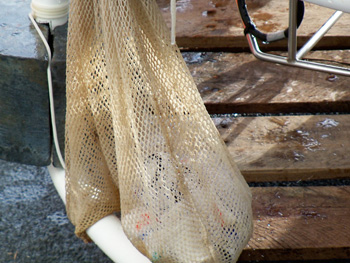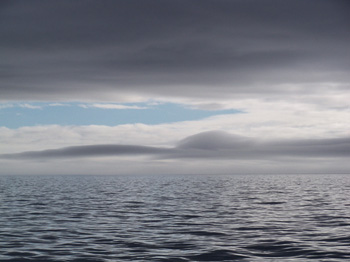Please note: You are viewing
the unstyled version of this website. Either your browser does not support CSS
(cascading style sheets) or it has been disabled. Skip
navigation.
Here are the first set of questions from a selection of students. I hope that you will enjoy finding out the answers for us. Many thanks, we look forward to your reply and will enjoy reading the questions and answers from the other partner schools. Best wishes, Sally Harden Hello Mrs. Harden, We'll be delighted to answer these questions. I'm looking forward to the "Mug of Hot Tea" experiment and more questions in the future. --Pat Keoughan YEAR 10 HAVE BEEN STUDYING HEAT LOSS/TRANSFER FROM HOT OBJECTS AND IN PARTICULAR HOW HEAT IS LOST FROM A MUG OF HOT TEA!! (HOW VERY ENGLISH OF US!) QUESTION 1 WE WOULD LIKE TO KNOW HOW LONG IT TAKES FOR HOT TEA TO FREEZE WHEN A MUG OF HOT TEA IS TAKEN ON TO THE DECK? QUESTION 2 WOULD IT BE POSSIBLE TO DO A TEMPERATURE PROFILE FOR US…TEMPERATURE V TIME? QUESTION 3 DOES IT ACTUALLY FREEZE? (Ben and I will be doing this experiment when we can find a good stretch of time and will send the results to you and publish them on the website.) QUESTION 4 WHAT IS THE AIR TEMPERATURE AND AVERAGE WIND SPEED AT MIDDAY? Answered by Ben Harden, Outreach Team and Meteorologist: I've plotted up some of the meteorological data recorded on the ship since the start of the cruise. The plot shows the wind speed and temperature measured by the meteorological equipment mounted on the bow of the ship. As you can see, we've seen quite a range of conditions so far. The wind speed has varied between almost no wind and 17 m/s (34 knots, 38 mph, or force 7). Dr. Bob has told me that the strength of these winds is easily large enough to have an influence on the currents that he is measuring in the region. The temperature has also varied quite a lot. We've seen temperatures almost as warm as 10 degrees centigrade and only on one occasion did the temperature drop below freezing! Remember though, this is the Arctic summer and we are only operating at about 70 degrees north, so it's perhaps warmer than you (or indeed I before joining the cruise) might have thought. SIXTH FORM STUDENT (PRE UNIVERSITY): QUESTION 5 BEN (HARDEN) MENTIONED THE CRUSHING PRESSURE ON A POLYSTYRENE MUG WHEN IT WAS LOWERED DEEP INTO THE WATER. DO YOU KNOW AT WHAT DEPTH IT BEGAN TO DISTORT? Answered by Ben Harden, The pressure in the ocean increases as you go deeper due to the larger weight of water above. At 100 metres depth, the pressure is about 10 times that at the surface. At 1000 metres it is 100 times greater. The volume of an air bubble changes due to the pressure exerted on it according to Boyle's law: The volume is inversely proportional to the pressure. So if you take an air bubble of 1 litre at the surface and take it down to 1000 metres its volume will be 10 ml. If this bubble were spherical, that's the same as its diameter reducing to about a fifth of its starting size. Polystyrene (Styrofoam) cups are made up of plastic interspersed with air bubbles. According to the above, these bubbles will compress as the cup is lowered through the water. Presumably if the cup is lowered only a small distance and brought back up, the cup would shrink on the way down due to the compressed air bubbles and then consequently expand to its original size on the way back up. There must be a critical depth, though, where something happens that can not be undone in this way. I'd imagine that the bubbles eventually become small enough such that they can escape the plastic prison of the cup and at this stage the air will be lost and the cup will be shrunk irreversibly. It would be great (if we had enough cups to spare, but currently they're at a bit of a premium!) to perform a series of experiments to see where this critical depth was, but the current wisdom says that anything deeper than 1000 metres will crush them pretty well. It is probable that a smaller depth would be required to distort the cup at least a little.
QUESTION 6 HOW DOES THE TEMPERATURE OF THE SEA VARY OVER A PERIOD OF A YEAR AND HOW DOES THIS COMPARE TO THE RELATIVE CHANGE AROUND THE COAST OF THE UK? Answered by Ben Harden: The sea surface temperature in this part of the world varies a great deal throughout the year. At it's coldest, the sea in this region is covered with sea ice. This necessarily reduces the temperature of the sea surface to about -2 degrees centigrade. This is the case for much of the winter until the ice melts in spring and the sun can warm the water. The sea here is at its warmest in the summer. This is due not only to the warming influence of the sun in the region, but to an influx of meltwater from the land masses of Alaska and Russia. This meltwater, which is warm and fresh (i.e. not salty) forms a strong surface current which flows through the the Bering Strait and along the west and then north coasts of Alaska. It is actually one of the currents that Dr Bob is interesting in measuring. We actually observed this current earlier in the cruise! In this current, we measured with temperatures of about 8 degrees centigrade at their maximum. This is still cold compared with the warmest sea temperatures we see around the UK in the late summer. In southwest UK, the ocean reaches a high of on average 18 degrees centigrade at this time. During the winter it reduces to about 6 degrees centigrade. The difference in temperature between the seas around the UK and those just to the north of Alaska are not only produced by the difference in latitude. The UK is also fed by warm water which travels all the way from the Caribbean in the Gulf Stream. This gives us a very warm ambient sea temperatures which are then enhanced further by warmth from the sun in the summer.
Last updated: September 29, 2010 | |||||||||||||||||||||
Copyright ©2007 Woods Hole Oceanographic Institution, All Rights Reserved, Privacy Policy. | |||||||||||||||||||||




